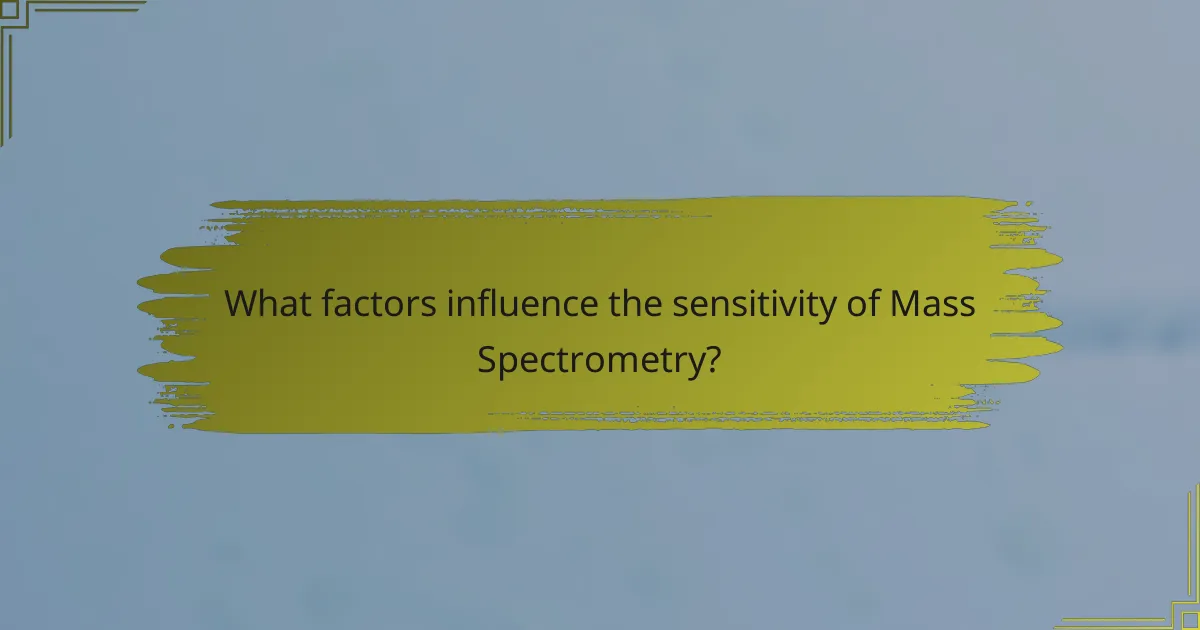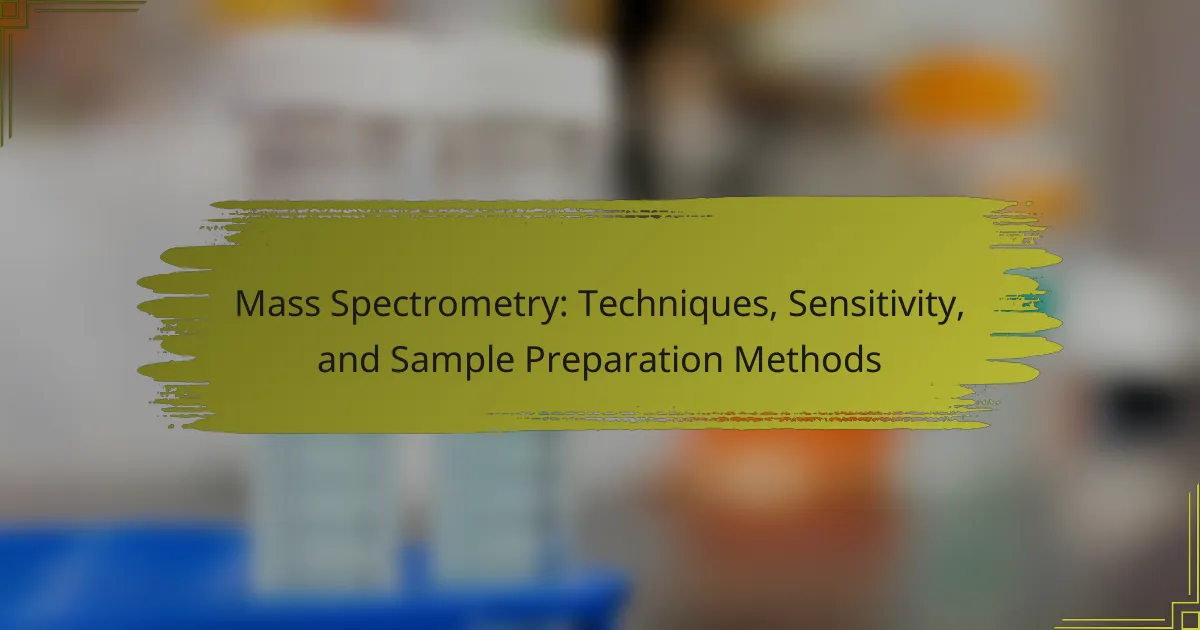
What is Mass Spectrometry?
Mass spectrometry is an analytical technique used to measure the mass-to-charge ratio of ions. This method allows for the identification and quantification of various substances. It involves ionizing chemical compounds to generate charged molecules or molecule fragments. These ions are then manipulated by electric and magnetic fields. The resulting data is used to determine the composition of a sample. Mass spectrometry is widely used in fields like chemistry, biology, and environmental science. Its sensitivity can detect substances at very low concentrations, often in the picogram range. This technique has become essential for analyzing complex mixtures and biomolecules.
How does Mass Spectrometry work?
Mass spectrometry works by ionizing chemical species and sorting the ions based on their mass-to-charge ratio. The process begins with sample ionization, which can occur through methods like electron impact or electrospray ionization. Once ionized, the resulting ions are accelerated into a mass analyzer. The mass analyzer separates the ions according to their mass-to-charge ratios. Common types of mass analyzers include quadrupoles and time-of-flight analyzers. After separation, ions are detected, often using a detector like an electron multiplier. The resulting data is then processed to generate a mass spectrum, which displays the abundance of each ion. This technique allows for the identification and quantification of compounds in a sample. Mass spectrometry is widely used in fields such as proteomics and metabolomics for its sensitivity and precision.
What are the key components of a Mass Spectrometer?
The key components of a mass spectrometer include the ion source, mass analyzer, and detector. The ion source generates ions from the sample. Common ionization methods include electron impact and electrospray ionization. The mass analyzer separates ions based on their mass-to-charge ratio. Types of mass analyzers include quadrupole, time-of-flight, and ion trap. The detector measures the abundance of the separated ions. Common detectors include electron multiplier and Faraday cup. Each component plays a crucial role in analyzing the sample’s composition. Together, they enable precise mass spectrometry measurements.
How is ionization achieved in Mass Spectrometry?
Ionization in mass spectrometry is achieved through various techniques that convert sample molecules into ions. Common methods include electron impact ionization, where high-energy electrons collide with molecules, resulting in ion formation. Another technique is electrospray ionization, which creates ions by applying a voltage to a liquid sample. This method produces charged droplets that evaporate, leaving behind ions. Matrix-assisted laser desorption/ionization (MALDI) is also used, where a laser pulse ionizes the sample embedded in a matrix material. Each of these methods effectively generates ions for analysis in mass spectrometry, enabling the identification and quantification of compounds.
What are the main techniques used in Mass Spectrometry?
The main techniques used in mass spectrometry are electron ionization, chemical ionization, and electrospray ionization. Electron ionization involves bombarding gas-phase molecules with electrons to create ions. This technique is commonly used for small, volatile compounds. Chemical ionization uses ion-molecule reactions to produce ions and is gentler than electron ionization. Electrospray ionization generates ions from solutions, making it suitable for large biomolecules. Other techniques include matrix-assisted laser desorption/ionization and time-of-flight mass spectrometry, which enhance the analysis of complex samples. These techniques enable the identification and quantification of various substances in analytical chemistry.
What is the difference between Electrospray Ionization and Matrix-Assisted Laser Desorption/Ionization?
Electrospray Ionization (ESI) and Matrix-Assisted Laser Desorption/Ionization (MALDI) are both ionization techniques used in mass spectrometry. ESI generates ions by applying a high voltage to a liquid sample, creating a fine aerosol. This technique is particularly effective for polar and thermally labile compounds. In contrast, MALDI uses a laser to vaporize a matrix material that absorbs laser energy, leading to the desorption and ionization of analytes. MALDI is suitable for larger biomolecules and provides high mass accuracy. ESI typically allows for continuous flow of samples, while MALDI is often used for discrete sample spots on a target plate. These differences make ESI ideal for analyzing complex mixtures and MALDI advantageous for analyzing proteins and polymers.
How do different Mass Analyzers affect results?
Different mass analyzers influence results by varying resolution, accuracy, and sensitivity. Quadrupole analyzers provide good sensitivity but lower resolution compared to time-of-flight (TOF) analyzers. TOF analyzers offer high resolution, allowing for better differentiation of closely related ions. Ion trap analyzers can accumulate ions, enhancing sensitivity for trace analysis. Each analyzer type has specific mass ranges and operational parameters that affect detection limits. For instance, TOF analyzers can detect a wider mass range than quadrupole analyzers. The choice of mass analyzer directly impacts the quality and reliability of the mass spectrometry results.

What factors influence the sensitivity of Mass Spectrometry?
Sensitivity in mass spectrometry is influenced by several key factors. These factors include ionization efficiency, the type of mass spectrometer used, and the sample introduction method. Ionization efficiency directly affects how many ions are produced from the sample. Different ionization techniques, such as Electrospray Ionization (ESI) or Matrix-Assisted Laser Desorption/Ionization (MALDI), yield varying efficiencies.
The type of mass spectrometer also plays a crucial role. Instruments such as Quadrupole, Time-of-Flight (TOF), and Orbitrap have different designs that affect sensitivity. Additionally, the resolution and detection limits of the mass spectrometer impact the ability to detect low-abundance analytes.
Sample preparation methods significantly influence sensitivity as well. Proper sample purification and concentration can enhance the detection of target compounds. The matrix effects from sample components can either enhance or suppress signal intensity, affecting overall sensitivity.
Environmental factors, such as temperature and pressure, also contribute to sensitivity variations. Maintaining optimal conditions during analysis is essential for achieving reliable results.
How does sample preparation impact sensitivity?
Sample preparation significantly impacts sensitivity in mass spectrometry. Proper sample preparation enhances analyte concentration and reduces matrix effects. Techniques such as extraction, filtration, and concentration can improve detection limits. For instance, solid-phase extraction can selectively isolate target compounds from complex samples. This process minimizes interference from other substances. Consequently, it allows for more accurate quantification of analytes. Studies show that optimized sample preparation can increase sensitivity by several orders of magnitude. Therefore, effective sample preparation is crucial for achieving reliable mass spectrometry results.
What are common sample preparation methods used in Mass Spectrometry?
Common sample preparation methods used in Mass Spectrometry include liquid-liquid extraction, solid-phase extraction, and protein precipitation. Liquid-liquid extraction separates compounds based on solubility differences in two immiscible liquids. This method is effective for isolating analytes from complex matrices. Solid-phase extraction utilizes a solid adsorbent to selectively retain and elute target compounds. It enhances sensitivity and reduces matrix effects. Protein precipitation involves adding a precipitating agent to remove proteins from biological samples, simplifying analysis. These methods are widely used to improve the accuracy and reliability of mass spectrometric analyses.
How can sample contamination affect results?
Sample contamination can significantly skew results in mass spectrometry. Contaminants can introduce foreign substances into the sample. This can lead to inaccurate mass measurements and erroneous identification of compounds. For instance, trace levels of contaminants can cause false positives or negatives. Additionally, contamination can affect the sensitivity of the analysis. A study published in the Journal of Mass Spectrometry highlighted that even minute levels of contamination can alter the ionization efficiency. This can ultimately compromise the reliability of the analytical results.
Why is sensitivity important in Mass Spectrometry?
Sensitivity is crucial in mass spectrometry because it determines the ability to detect and quantify low-abundance analytes. High sensitivity allows for the identification of trace compounds in complex mixtures. This is particularly important in fields such as environmental monitoring and clinical diagnostics. For example, detecting pollutants at parts per trillion levels requires high sensitivity. Additionally, sensitivity impacts the overall accuracy and reliability of the results. Enhanced sensitivity can lead to better signal-to-noise ratios, improving data quality. In summary, sensitivity directly influences the effectiveness of mass spectrometry in various applications.
What are the implications of high sensitivity in analytical applications?
High sensitivity in analytical applications allows for the detection of low concentrations of analytes. This capability enhances the accuracy of quantitative measurements. In mass spectrometry, high sensitivity leads to improved signal-to-noise ratios. It enables the identification of trace compounds in complex mixtures. High sensitivity can also reduce sample volume requirements, making analyses more efficient. Additionally, it facilitates the study of biomolecules at low abundance. This is critical in fields like environmental monitoring and clinical diagnostics. High sensitivity ultimately expands the applicability of analytical techniques across various scientific disciplines.
How does sensitivity vary across different Mass Spectrometry techniques?
Sensitivity varies significantly across different Mass Spectrometry techniques. Techniques like Electrospray Ionization (ESI) generally offer higher sensitivity for polar and thermally labile compounds. Matrix-Assisted Laser Desorption/Ionization (MALDI) provides good sensitivity for larger biomolecules but may be less sensitive for small molecules. Gas Chromatography-Mass Spectrometry (GC-MS) typically has high sensitivity for volatile compounds due to efficient ionization. In contrast, Liquid Chromatography-Mass Spectrometry (LC-MS) offers high sensitivity for a broader range of analytes, including non-volatile and polar substances. The choice of ionization technique impacts sensitivity due to factors like ionization efficiency and sample matrix effects. Overall, the specific application and analyte characteristics dictate the sensitivity achieved in each Mass Spectrometry method.

What are the best practices for sample preparation in Mass Spectrometry?
Best practices for sample preparation in mass spectrometry include ensuring sample purity, optimizing sample concentration, and minimizing contamination. Sample purity is critical as impurities can interfere with results. Using high-quality reagents and solvents helps achieve this. Optimizing sample concentration enhances detection limits. Typically, concentrations between 1 ng/µL to 100 µg/µL are recommended, depending on the analyte. Minimizing contamination involves using clean lab equipment and proper handling techniques. Additionally, employing techniques like solid-phase extraction can improve analyte recovery. Consistent sample storage conditions also preserve sample integrity. Following these practices enhances the reliability of mass spectrometry results.
What steps should be followed for effective sample preparation?
Effective sample preparation involves several key steps. First, select the appropriate sample type based on the analysis goals. Next, ensure proper collection techniques to avoid contamination. Then, homogenize the sample to achieve uniformity. Follow this by extracting the target compounds using suitable solvents or methods. After extraction, concentrate the sample if necessary to enhance sensitivity. Finally, filter or centrifuge the sample to remove particulates before analysis. Each of these steps is critical for achieving accurate and reliable results in mass spectrometry.
How can one minimize sample loss during preparation?
To minimize sample loss during preparation, use careful handling techniques. Employing proper pipetting methods reduces the risk of droplet formation. Maintaining a clean workspace prevents contamination and loss of sample material. Utilizing appropriate containers minimizes evaporation during storage. Keeping samples at optimal temperatures limits degradation. Implementing quick transfer methods reduces exposure time to air. Using centrifugation effectively separates components without sample loss. Lastly, documenting all procedures ensures reproducibility and minimizes errors. These strategies collectively enhance sample integrity and recovery rates.
What role does solvent choice play in sample preparation?
Solvent choice is critical in sample preparation for mass spectrometry. The selected solvent influences analyte solubility, extraction efficiency, and ionization. Different solvents can enhance or inhibit the detection of specific compounds. For instance, polar solvents may dissolve hydrophilic analytes better than non-polar solvents. This can affect the overall sensitivity of the mass spectrometry analysis. Furthermore, the solvent’s volatility impacts the sample’s stability during analysis. Proper solvent selection can minimize matrix effects and improve signal-to-noise ratios. Ultimately, the right solvent ensures optimal conditions for accurate mass spectrometric measurements.
What common challenges exist in sample preparation for Mass Spectrometry?
Common challenges in sample preparation for Mass Spectrometry include contamination, matrix effects, and sample degradation. Contamination can introduce extraneous signals, complicating data interpretation. Matrix effects may alter ionization efficiency, leading to inaccurate quantification. Sample degradation can occur due to chemical reactions or environmental factors, affecting analyte stability. Additionally, achieving reproducibility can be difficult, as variations in sample handling may impact results. Proper optimization of extraction methods is essential to mitigate these issues.
How can one troubleshoot issues in sample preparation?
To troubleshoot issues in sample preparation, first identify the specific problem. Common issues include contamination, improper dilution, and inadequate mixing. Assess the sample for visible contaminants. Use clean tools and containers to prevent cross-contamination. Check dilution ratios against standard protocols to ensure accuracy. Ensure thorough mixing to achieve homogeneity in the sample. Additionally, verify that reagents are fresh and properly stored. Review the sample preparation method for adherence to established guidelines. Regular calibration of equipment can also minimize errors. Document each step to trace back any inconsistencies effectively.
What resources are available for optimizing sample preparation techniques?
Resources for optimizing sample preparation techniques include academic journals, online databases, and technical manuals. Academic journals such as “Journal of Mass Spectrometry” publish peer-reviewed studies on innovative preparation methods. Online databases like PubMed and Scopus provide access to a wide range of research articles. Technical manuals from equipment manufacturers offer guidelines specific to their instruments. Websites of professional organizations, such as the American Society for Mass Spectrometry, provide resources and networking opportunities. Workshops and webinars hosted by industry experts also serve as valuable educational tools. These resources collectively enhance knowledge and improve methodologies in sample preparation for mass spectrometry.
Mass spectrometry is an analytical technique that measures the mass-to-charge ratio of ions, enabling the identification and quantification of various substances. The article explores the fundamental working principles of mass spectrometry, including ionization methods such as electron impact and electrospray ionization, and the role of mass analyzers like quadrupoles and time-of-flight analyzers. It emphasizes the importance of sensitivity in detecting low-abundance analytes and discusses best practices for sample preparation, including common methods and challenges faced during the process. Key factors influencing sensitivity and the implications of high sensitivity in analytical applications are also addressed, providing a comprehensive overview of mass spectrometry’s techniques and methodologies.
